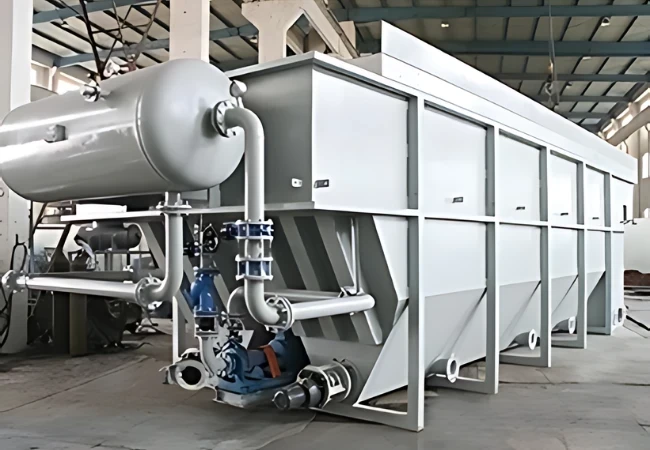Dissolved Air Flotation (DAF): A Comprehensive Overview
Dissolved Air Flotation (DAF) is a powerful water treatment technology designed to separate contaminants from wastewater using air bubbles and chemicals. This blog will guide you through the key processes involved in DAF and explain how it efficiently purifies water.
The Dissolved Air Flotation (DAF) Process
-
Aeration
The DAF process begins with aeration, where air is dissolved into the wastewater under high pressure—typically between 3 to 5 bar. This pressurized air forms the foundation for the subsequent steps in the treatment process.
-
Mixing
Once the air is dissolved, the wastewater may be mixed with chemicals if needed. These chemicals aid in flocculation (the process of clumping particles together) and enhance sedimentation, making the separation of contaminants more effective.
-
Flotation
The air-rich wastewater then flows into a flotation tank where the pressure is suddenly reduced. This drop in pressure causes the dissolved air to form tiny bubbles within the wastewater.
-
Attachment
These microscopic bubbles attach to suspended solids, oils, and greases. The buoyant force of the bubbles causes these contaminants to rise to the surface of the tank.
-
Separation
At the surface, the accumulated contaminants are skimmed off by a skimmer. This effectively removes the impurities from the wastewater. The clarified water, which is now cleaner, is discharged from the bottom of the tank.
-
Clarification
The final step involves further clarification and, if necessary, disinfection of the treated water to ensure it meets regulatory standards for discharge or reuse.
The DAF water treatment system separates oils, solids, and other contaminants by dissolving air in the wastewater under pressure. Then, the air at atmospheric pressure in a flotation tank. DAF wastewater treatment is effective in releasing even low-density particles. These systems are widely used for water purification in various industrial applications.
Components of a Dissolved Air Flotation System
Before wastewater enters the DAF unit, it undergoes preliminary treatments like screening and sedimentation to remove large particles and settleable solids. This pre-treatment prevents clogging and excessive buildup in the DAF unit, ensuring efficient operation.
A typical DAF system includes:
- Flotation Basin: The main chamber where the DAF process occurs.
- Air Dissolution System: A pump and saturation tank that introduces air into the wastewater under pressure.
- Flocculation Chamber (Optional): Where chemicals are added to promote floc formation before the wastewater enters the flotation tank.
- Skimmer: Mechanism for removing floated contaminants from the surface.
- Clarified Water Outlet: Where the treated, clarified water exits the system.
In the flotation basin, air is introduced into the wastewater under pressure, creating microscopic bubbles. These bubbles attach to suspended particles, causing them to float. In some systems, a flocculation chamber upstream of the flotation tank may enhance the formation of larger flocs. The skimmer then collects the floated contaminants, and the clarified water exits the unit, ready for further treatment or discharge.
Dissolved Air Flotation Methodology Explained
The DAF methodology involves several key steps to effectively remove pollutants from wastewater:
- Air Dissolution: Air is dissolved into the wastewater under pressure. When the pressure is released in the flotation tank, the air forms microscopic bubbles that help in the separation process.
- Coagulation: This initial step involves adding coagulants such as aluminum sulfate or ferric chloride to destabilize particles and promote their aggregation into larger clusters called flocs. Coagulants neutralize the negative charges on suspended particles, allowing them to clump together.
- Flocculation: Following coagulation, flocculation gently mixes the wastewater to form larger, heavier flocs. These flocs are easier to remove as they either attach to microbubbles and float to the surface or settle at the bottom.
- Flotation and Removal: The formed flocs, along with air bubbles, rise to the surface where they are skimmed off by the skimmer and collected for further processing or disposal.
By integrating these steps, DAF enhances the sedimentation and flotation of pollutants, resulting in cleaner, clarified water that meets environmental standards.
Dissolved Air Flotation (DAF) is a highly efficient method for treating wastewater, leveraging air bubbles and chemical processes to effectively separate and remove contaminants. At Alantech, we pride ourselves on being the leading industrial water treatment plant manufacturers. Understanding the detailed process and methodology behind DAF highlights how this advanced technology plays a crucial role in achieving cleaner water and enhancing environmental management.


